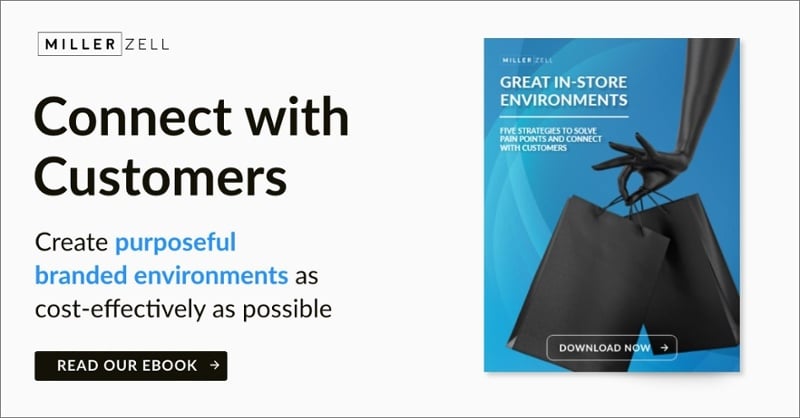Fixtures & Décor: Producing Value, Great Customer Experiences
Consider five classic challenges for a diverse group of branded environments:
-
A convenience store wanted to differentiate itself from its competition and feel more like a farmer’s market than a “cokes and smokes” gas station.
-
A restaurant wanted to adopt a smaller footprint concept specifically for takeout and delivery while not sacrificing its brand equity.
-
A bank created an impressive new branch design, but it was cost prohibitive to scale.
-
A major university wanted to refresh and expand the utility of its student center, making it digitally interactive and customizable.
-
A national auto parts chain wanted to transform its store interiors to appeal to a wider customer base.
Each of these starts with design. Each leans hard into refreshed fixtures and décor.
So how do you guarantee what you see on paper with a design is optimally adopted inside your branded environment?
Don’t cut corners with fixtures and décor
Ensure on-brand design and efficient execution of fixtures and décor programs by paying close attention to every detail from ideation through installation. Evaluate each fixture and décor element and determine its core function. Then identify engineering opportunities that add value while maintaining or improving functionality.
Take the five examples from above. They focus on: 1. Differentiation; 2. Brand equity; 3. Value engineering; 4. Digital integration; 5. Customer experience.
Most major programs touch on each of these to varying degrees. Each involves specific needs for décor and fixtures, which are foundational to purposeful branded environments that produce ROI. So three questions are worth asking throughout design development and then program execution.
Does each element:
- Achieve its functional purpose, whether that’s about omnichannel integration, wayfinding, queueing or providing clear, succinct information via print or digital signage?
- Connect with a variety of customers and build brand attraction and then loyalty?
- Optimize the customer and associate experience and solve pain points?
Successful environmental branding requires décor and fixtures that are both appealing and purposeful, providing solutions while not creating new friction — such as an impressive new fixture that ends up ruining sight lines after installation.

Napa Auto Parts Association (NAPA) store-refresh wanted to improve its connection with average retail customers while maintaining affinity with it's seasoned gear heads and professional mechanics.
The convenience store aiming to differentiate itself from its competition still needs to serve customers in a rush, just as the restaurant adopting a new, smaller concept still wants to maintain or elevate its longstanding brand equity. An auto parts chain trying to improve its connection with average retail customers doesn’t want to damage the affinity it’s developed with seasoned gear heads and professional mechanics.

Southern Methodist University (SMU) reimagined their Hughes-Trigg Student Center and "Gallery 1911" with next-generation technology and strategic functionality.
And a university refreshing a key gathering space wants to build brand affinity within a diverse student body and alumni demographics by simultaneously honoring the past while leaning into an immersive digital future.
Or specifically consider a great new end cap design. It’s a good start, but will it work at scale for a variety of aisle signage specifications? And what about its functional versatility, such as interchangeable graphics, shelving flexibility and a capability to fit multiple end cap sizes? That’s where store audits, A/B testing and prototyping provide answers.
Further, when kit packing for rollout to hundreds or thousands of stores, are there ways to cut shipping costs? The details matter when aiming for ROI.
Executing optimized décor and fixture programs can be complicated. To design and implement, they require a holistic understanding of store strategy, branding, space optimization principles, digital integration, value engineering, prototyping, merchandising, wayfinding, procurement, production, program management and installation.
A solution? True end-to-end services
When designers, engineers, program managers, supply chain specialists, installation experts and customizable logistics technology collaborate under one roof — becoming, in fact and execution, a true partner with your team — a campaign won’t falter due to a series of burdensome handoffs or vendor-to-vendor misjudgments or miscommunication.
Industrial, environmental and CAD designers and architectural services can provide both creative and cost advantages as they develop plans for store layouts, interior elevations, overhead signage, fixtures and décor. Design engineers bring value by paying particular attention to specifications and fabrication details and providing value engineering whenever possible.
Costs are managed with an eye toward scale, which includes a detailed understanding of program-wide expenses, along with shipping, consolidation and installation.
Further, the international supply chain quagmire intersects with just about every business endeavor these days. Procurement management expertise with overseas and domestic partners is a big differentiator when developing branded environments. It also can navigate quality control processes and shipping logistics to save time and money.
A branded environment campaign is elevated when diverse and creative expertise is centralized, as well as when the collaborative process obsessively seeks innovation, efficiency and cost savings.
